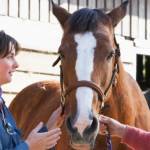Fit to be Tied: Part Two

In the second part of a three-part series, another form of tying-up, recurrent exertional rhabdomyolysis (RER) is discussed in detail (see Fit to be Tied: Part One).
RER is common in nervous fillies of Arabian, Standardbred, and Thoroughbred breeding. It is a common disorder, as 5 to 10% of Thoroughbred racehorses develop tying-up each season and most of these horses have several episodes, while about 13% of polo horses have been shown to tie-up during a year. These individuals often develop the condition when they are excited, stressed, and/or a period of stall rest preceding exercise has occurred. Preliminary genetic research and breeding trials point to this condition as an inherited trait in Thoroughbred and Standardbred horses and further studies are underway.The exact cause of RER in horses has challenged scientists for several years. RER in racing horses was believed to be similar to lactic acidosis. However, recent research has shown muscle lactate concentrations to be low, not high, in these horses when tying-up occurs. Most recently RER is thought to be an abnormality in the way muscle contraction is regulated in the horse. Muscle biopsies from horses with RER have revealed an increased sensitivity to contraction when exposed to various chemicals compared to normal horses. The altered contraction and relaxation of muscle suggests that abnormal intracellular calcium regulation is the cause of RER.
Tying-up in susceptible horses is affected by gender, temperament, excitement, stress, dietary starch, exercise duration/intensity, season, and lameness. Females are most commonly afflicted with RER (67% female; 33% male), particularly those that are two years of age and in training. Nervous horses are five times more likely to develop RER, and horses with lameness are four times more likely to develop RER. Many owners report that episodes of rhabdomyolysis occur most commonly when a filly or mare is in season, but in one study of racehorses no direct correlation was shown between progesterone fluctuations and serum CK activity. It is likely that the estrus cycle is one of many risk factors that combine to trigger tying-up in susceptible horses.
Susceptible horses receiving more than 11 lb (5 kg) of concentrate are more likely to develop RER than those receiving 5.5 lb (2.5 kg) of concentrate per day. Dietary effects of high carbohydrate in RER may in part be related to the psychogenic effects of grain on excitability as glycogen storage does not increase substantially in horses with RER. Inclement weather has also been cited as a trigger of RER.
Treatment and prevention for horses experiencing RER may require veterinary assistance. Management designed to make the horse comfortable and prevent further stress and muscle damage is warranted. The use of sedatives prior to exercise to calm a nervous horse is also a common preventive practice. Other drugs designed to regulate intracellular sodium and calcium are now being prescribed for horses.
Daily exercise for horses diagnosed with RER is essential. Beginning approximately 24 hours after an RER episode, horses should be hand walked or turned out on a daily basis. Prolonged stall rest after an episode seems to be counterproductive and may predispose the horse to further episodes of RER once training resumes. A horse kept in a stable will usually do better if it has daily or full-time turnout as well as daily exercise. Thoroughbreds may need less slow work and more fast work or might benefit from swimming before being worked. Standardbreds may benefit from shorter jog times (<15 min) with either two intervals or greater jog speed being used to get the work into the horse. Eventers may require training that provides calm exposure to speed work and interval training to achieve the right combination of speed and distance.
Prevention of further episodes of RER is difficult. Controlling the environment of these horses is essential. An environment that is not stressful with a well-established daily routine seems to help. This can include order of feeding, order of work, work rider, work partner, and particularly avoiding work where the horse fights the rider
A nutritionally balanced diet with appropriate caloric intake and adequate vitamins and minerals is the core element of treating all forms of tying-up. As with any horse, forage is recommended at a rate of 1.5-2% of body weight. In general, grass hay is preferable to alfalfa /lucerne hay.
Diets with a restricted amount of starch and sugar and supplemental calories supplied with fat are the basis for dietary management. For hard-working horses with RER, the challenge is supplying an adequate number of calories in a highly palatable feed to meet their daily energy demands. Out of the total daily calories required, it is recommended that less than 20% digestible energy (DE) be supplied by starch and at least 15% be supplied by fat. Vegetable oil and rice bran are the most common sources of fat in feeding horses with RER.
Controlled experimental studies using Thoroughbreds with RER show that serum CK activity is significantly lower when horses are fed a specially formulated high-fat, low-starch feed (Re-Leve®, KER) rather than an isocaloric amount of high-starch grain. Given the close relationship between nervousness and RER, reducing anxiety and excitability by reducing dietary starch and increasing dietary fat may reduce the risk by making these horses calmer prior to exercise. To increase a horse’s energy during the race, some racehorse trainers prefer to supplement with a titrated amount of grain three days prior to a race if horses are on a low-starch, high-fat feed.








